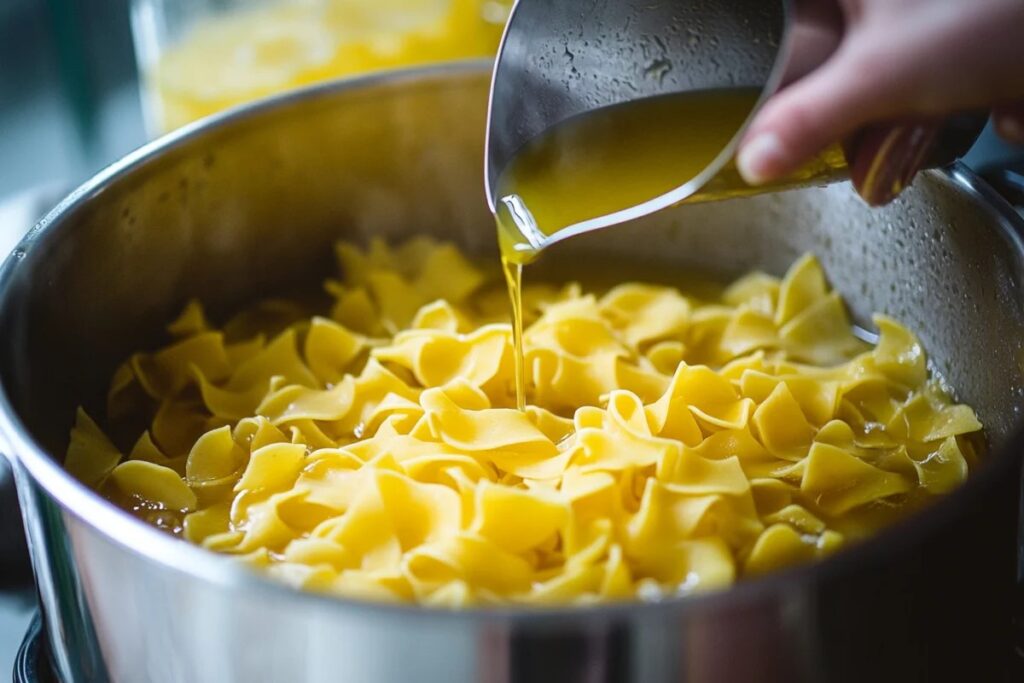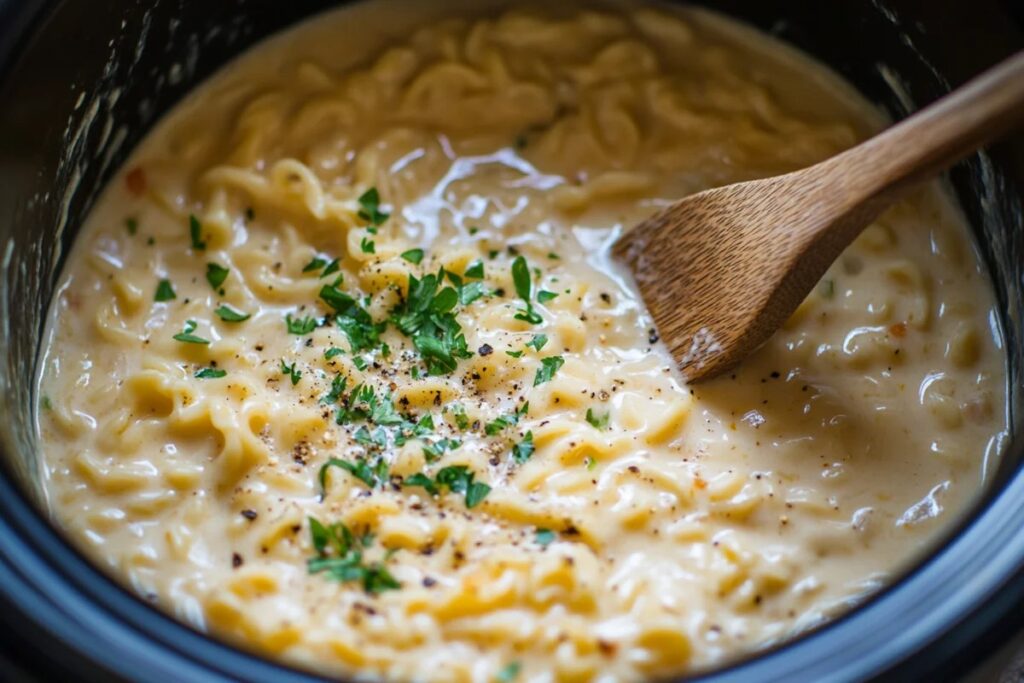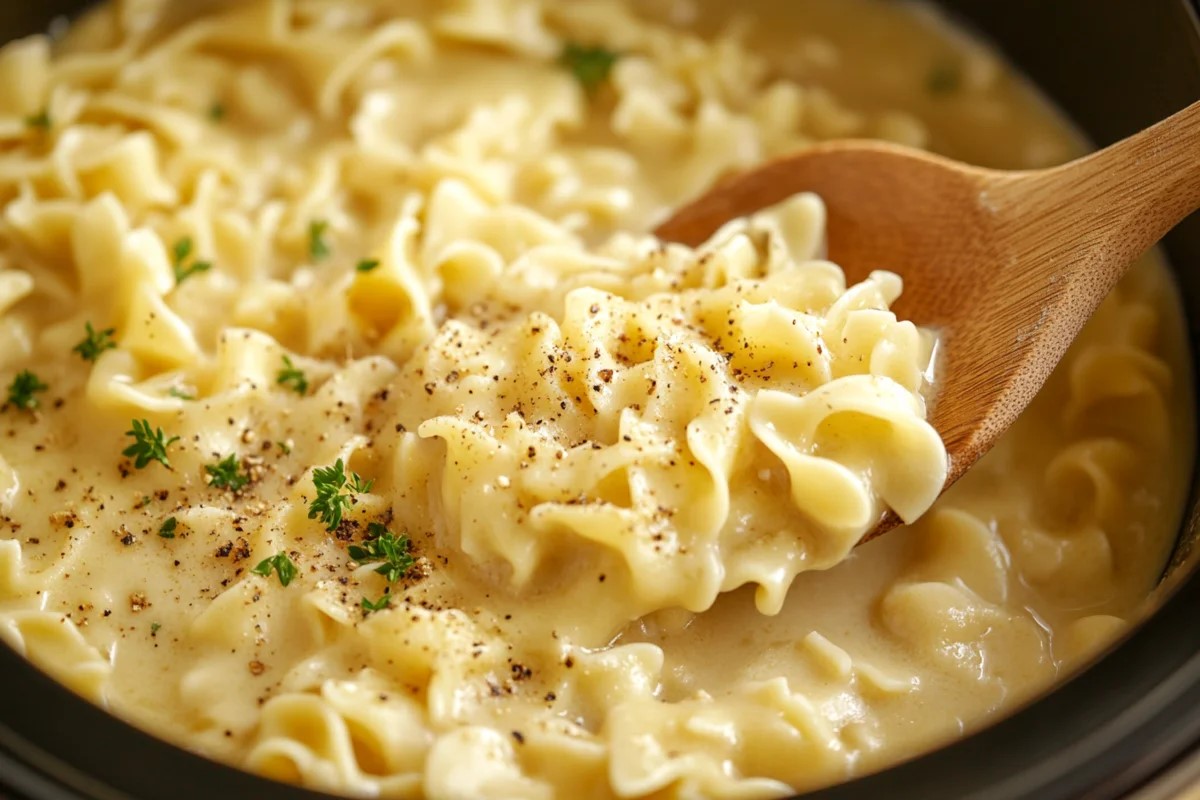Cooking egg noodles in a Crockpot can feel like walking a culinary tightrope. One wrong step—too much liquid, overcooking, or the wrong type of noodles—and you end up with a pot of unappetizing mush. But fear not! This article dives into why egg noodles tend to get mushy in slow cookers and offers foolproof tips to keep your noodles tender yet firm. Whether you’re a seasoned chef or a busy home cook, this guide will save your dishes and your day.
Common Reasons for Mushy Egg Noodles in the Crockpot
Excess Moisture in the Crockpot
One of the main culprits for mushy egg noodles is excess moisture. Slow cookers are designed to retain liquid, which creates a moist cooking environment. While this is perfect for tenderizing meats and simmering sauces, it can wreak havoc on delicate noodles.
Egg noodles are especially absorbent and will soak up all the broth or sauce in the pot. If there’s too much liquid, the noodles absorb more than they can handle, losing their structure and becoming soggy. It’s not just about how much liquid you use—it’s also about when you add it.
Overcooking Noodles in Slow Heat
Egg noodles are not built to withstand prolonged exposure to heat, even low heat. Unlike tougher pasta varieties, their delicate structure breaks down quickly in a Crockpot. Cooking noodles for hours alongside other ingredients might seem convenient, but it’s a surefire way to end up with a mushy mess.
Adding noodles too early in the cooking process is a common mistake. The slow cooker’s low and steady heat continues to cook the noodles well beyond their ideal tenderness, turning them into mush.
Using the Wrong Type of Egg Noodles
Not all noodles are created equal, and this is especially true when it comes to slow cooking. Thin, delicate egg noodles are more prone to becoming gummy or breaking apart. While they may work beautifully in quick stovetop recipes, they often fall apart in the slow cooker’s humid environment.
Wide egg noodles, gluten-free varieties, or brands marketed as “no-boil” options are better equipped to handle the prolonged exposure to heat and liquid in a Crockpot.
With these three issues identified, you’re already on the road to improving your Crockpot dishes. In the next section, we’ll explore practical tips and tricks to avoid mushy noodles and create perfectly cooked meals every time.
Tips to Prevent Mushy Egg Noodles

Control the Amount of Liquid Added
The key to preventing mushy egg noodles in the Crockpot is controlling the liquid. Egg noodles absorb more liquid than you might expect, and too much broth or sauce can oversaturate them, turning them into a soggy mess.
Here’s a trick: Use 1 cup less liquid than your recipe suggests when incorporating egg noodles. For example, if the recipe calls for 6 cups of broth, start with 5 and adjust later if needed. Additionally, avoid submerging the noodles completely. Place them on top of the other ingredients to prevent soaking, as this minimizes their exposure to excess moisture.
When you’re ready to serve, stir in a small amount of liquid, if necessary, to achieve the right consistency. This simple tweak can save your dish!
Cook Noodles Separately or Add Late
One foolproof way to avoid mushy noodles is to cook them separately and mix them into the Crockpot meal just before serving. This method ensures the noodles maintain their texture while the rest of the dish cooks to perfection.
If you prefer one-pot cooking, add the noodles during the last 20-30 minutes of cooking. This timing aligns with their natural cooking duration and prevents overexposure to heat. To guarantee the right texture, use a timer and taste-test for doneness, pulling the noodles out as soon as they’re tender yet firm.
These steps reduce the risk of overcooking, keeping your noodles intact and appetizing.
Choose the Right Type of Egg Noodles
Not all noodles are made equal, especially for slow cooking. Wide egg noodles, gluten-free varieties, and “no-boil” brands stand up better to the long, moist cooking process. Their thicker texture and composition help prevent them from becoming gummy or falling apart.
Avoid thin or delicate egg noodles, as they’re more prone to becoming mushy. Brands like Barilla and Ronzoni, known for their durability, are excellent choices for slow cooker recipes. For more guidance on slow-cooker-friendly noodle types, check out Crockpot Beef Tips and Noodles.
Preparation and Cooking Techniques
Prepping the Noodles Before Cooking
Preparation is key to ensuring your egg noodles turn out perfectly. If using dried noodles, skip boiling them beforehand. Instead, let the hot liquid in the Crockpot gently hydrate and cook them. Pre-boiling makes the noodles absorb more moisture than necessary, increasing the likelihood of mushiness.
For fresh egg noodles, give them a quick pre-cook—just 1-2 minutes in boiling water—then shock them in an ice bath to stop the cooking process. This method helps maintain their shape when added to the Crockpot.
Tossing the noodles lightly in oil or sauce before cooking can also create a barrier, preventing excess liquid absorption.
Layering Ingredients Correctly
The placement of noodles in your Crockpot matters more than you’d think. Layer the noodles on top of other ingredients, like meat or vegetables. This keeps them away from the direct heat and reduces their exposure to liquid pooling at the bottom.
Additionally, resist the urge to stir the noodles frequently. Over-stirring can break them apart and release starch, creating a gummy texture.
Minimizing Stirring for Better Texture
While it’s tempting to check on your meal often, it’s best to avoid over-stirring noodles in the Crockpot. Stirring agitates the noodles, causing them to break and release starch, which further thickens the liquid and leads to a sticky consistency.
Once the noodles are added, let them cook undisturbed. Check them for tenderness only when your timer signals it’s time.
By following these preparation and cooking techniques, you’ll be able to answer the dreaded question, “Why did my egg noodles turn to mush in the Crockpot?” with confidence and a perfect plate of food.
Using Thickeners and Binders to Improve Texture

Thickeners to Maintain Noodle Structure
A little extra help from thickeners can go a long way in maintaining the integrity of egg noodles in the Crockpot. When noodles cook, they release starch into the surrounding liquid, which can lead to a watery texture and over-saturated noodles. Adding a thickening agent helps prevent this and keeps the dish cohesive.
Consider incorporating options like cornstarch, tapioca flour, or even potato starch directly into your recipe. These ingredients absorb excess moisture, ensuring the noodles stay firm. For best results, mix the thickener with a small amount of water to create a slurry before adding it to the Crockpot. This prevents lumps from forming.
If you’re cooking a creamy dish, dairy ingredients like ricotta, cream, or evaporated milk can add both thickness and richness, enhancing the noodles’ flavor and structure.
Tips for Adjusting the Consistency of Cooking Liquid
Even with the best planning, your dish might still end up with too much liquid. Don’t worry—there are quick fixes! If the noodles seem overly saturated, remove the lid and cook on high for about 10-15 minutes. This allows the excess moisture to evaporate naturally.
Alternatively, you can transfer the solids to another dish and reduce the remaining liquid on the stovetop. Adding a cornstarch slurry during this step can help thicken the liquid into a sauce-like consistency.
These strategies ensure your noodles remain tender yet firm, solving the common problem of Why did my egg noodles turn to mush in the Crockpot?
Frequently Asked Questions
How to Keep Egg Noodles from Getting Mushy?
The best way to keep egg noodles from getting mushy is to add them late in the cooking process or cook them separately. This minimizes their exposure to excess moisture and prolonged heat. Also, reducing the amount of liquid in your recipe can help prevent over-saturation.
Why Are My Noodles Gummy in the Crockpot?
Gummy noodles often result from too much stirring or using delicate, thin noodles. To avoid this, stir noodles sparingly and opt for sturdier varieties like wide egg noodles or gluten-free alternatives.
How to Keep Noodles from Turning to Mush?
Control the liquid, choose the right noodles, and time their cooking perfectly. Add noodles in the last 20-30 minutes of cooking or prepare them separately to maintain their texture.
Why Did My Noodles Turn to Mush?
If your noodles turned to mush, it’s likely due to overcooking, excess liquid, or the wrong noodle type. By following the tips in this guide—like reducing liquid, using thickeners, and choosing slow-cooker-friendly noodles—you can prevent this from happening again.
Troubleshooting Common Mistakes with Egg Noodles
Adding Noodles Too Early
One of the most frequent mistakes when using a Crockpot is adding egg noodles too early in the cooking process. Since slow cookers maintain a consistent, moist heat, noodles that sit for too long absorb more liquid than they should, breaking down into a mushy consistency.
The fix is simple: always add noodles during the final 20-30 minutes of cooking. This ensures they cook just enough to become tender while maintaining their structure. If you’re not sure when to add them, set a timer based on the overall cooking time.
Overusing Liquid
Too much liquid in a Crockpot recipe can drown your egg noodles, causing them to overhydrate and lose texture. This often leads people to wonder, “Why did my egg noodles turn to mush in the Crockpot?”
To avoid this, measure your liquid carefully. Reduce the amount by about a cup if your recipe includes noodles. You can always add more liquid at the end if needed, but removing excess moisture once the dish is cooked is much harder.
Conclusion and Final Tips
Mastering Egg Noodles in the Crockpot
Cooking egg noodles in a Crockpot doesn’t have to be a gamble. By understanding the common pitfalls—like overcooking and excessive liquid—you can take steps to ensure your noodles come out perfect every time. Timing is everything: add noodles late in the cooking process, use a timer, and choose sturdy noodle varieties that can withstand the slow cooker’s moist heat.
Final Thoughts
Why did my egg noodles turn to mush in the Crockpot? It’s a question many cooks ask, but the solution lies in the details. By managing liquid levels, using thickeners, and adding noodles strategically, you can prevent soggy noodles from ruining your meal.
If you’re experimenting with other slow-cooker recipes, try similar techniques to enhance your dishes. For hearty inspiration, check out other slow-cooked meals on Quinto Recipes, such as their popular. With practice and these simple tips, your Crockpot meals will always be a success!
Expert Tips for Consistently Perfect Egg Noodles
Timing Is Everything
Timing is crucial when cooking egg noodles in the Crockpot. Adding them too early is a common mistake, leading to the inevitable question: “Why did my egg noodles turn to mush in the Crockpot?” To avoid this, add noodles in the last 20-30 minutes of cooking. This ensures they cook to the perfect texture without overcooking.
If you’re juggling a busy schedule, setting a timer is your best friend. Once the noodles are added, keep an eye on the clock to ensure they don’t go beyond their recommended cooking time. This small step makes a big difference in preserving the texture of your dish.
Choose Noodles with Care
Not all egg noodles are created equal, and some are better suited for slow cooking than others. Wide egg noodles or brands specifically labeled for no-boil or slow-cooker use are ideal for Crockpot recipes. These noodles are designed to retain their firmness even in a moist, low-heat environment.
Avoid using delicate, thin noodles in slow cooker meals. They break down too easily, leaving you with a mushy texture that’s hard to salvage. For a list of great noodle options, consider exploring articles that recommend slow-cooker-friendly pasta types.
Why It’s Worth Getting It Right
Enjoying the Perfect Dish
Mastering the art of Crockpot cooking is all about the details. Perfectly cooked egg noodles can elevate your meal, adding the right amount of heartiness without compromising texture. No one wants their dish ruined by mushy noodles, and the good news is that small adjustments can save the day.
Whether you’re preparing a comforting chicken noodle soup or a creamy beef stroganoff, taking steps to avoid common mistakes will result in a dish that’s both satisfying and memorable. By managing liquid levels, timing your noodle addition, and choosing the right noodle type, you can ensure success every time.
Building Confidence in the Kitchen
If you’ve ever asked yourself, “Why did my egg noodles turn to mush in the Crockpot?”, know that you’re not alone. Even experienced cooks can make this mistake. However, with the tips and techniques outlined in this guide, you’ll feel more confident tackling any recipe. Cooking is a learning process, and mastering small details like these can significantly improve your results.
For more inspiration, check out slow-cooker recipes at Quinto Recipes, including hearty noodle dishes and other comforting favorites. You’ll soon find that perfecting your Crockpot skills opens up a world of possibilities for delicious, hassle-free meals.
